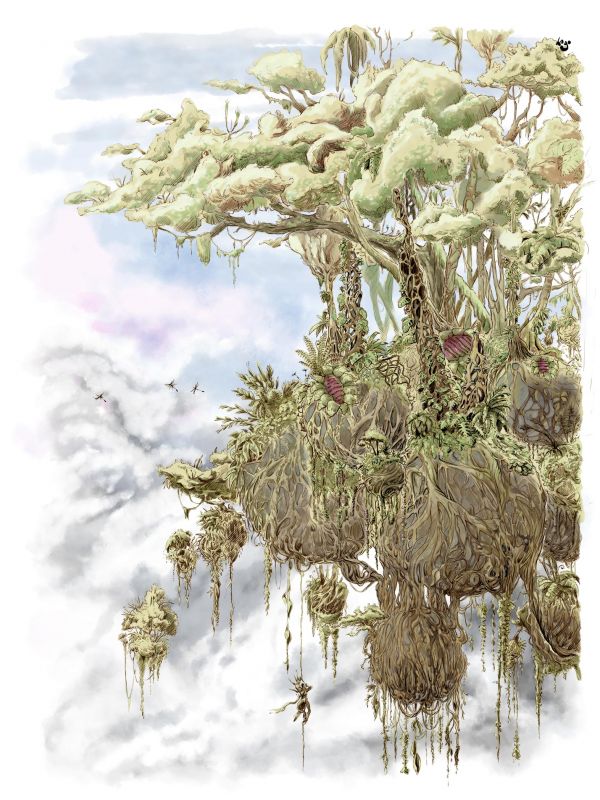Difference between revisions of "Air plants"
ScruffyHugo (talk | contribs) Tag: visualeditor-switched |
ScruffyHugo (talk | contribs) Tag: visualeditor-switched |
||
| Line 1: | Line 1: | ||
| − | + | [[File:2021_04_10_airPlantA_master2k.jpg|thumb|600px|border|right|An Air Forest typical of the valleys to the east of [[Land of Lume|Lume]]. Note the 'parachute' seeds, produced by apomixis, that make use of wind currents for wide dispersal. Dependent on a symbiotic ecosystem, these gardens procreate in various ways. Birds, insects and other wildlife also help to pollinate the numerous plants that grow on the gourds. A [[Dunefolk]] scales the vines in a risky attempt to gather rare ingredients and foodstuffs.]] | |
| − | |||
| − | + | ==''Tillandsia aeranthos''== | |
| + | Across the [[Lands of Lume|Continent]], and hovering anywhere from a few [[spans]] to hundreds of [[paces]] above the ground, incredible Floating Forests pepper the skyline, filling the skies with life. The large founding plants these forests grow on resemble gourds, each trailing tendrils of vines, their size and appearance dependent on the location. Surprisingly, the plains and deserts sport numerous forms of ''Tillandsia'', albeit of a less tropical persuasion. There are regions on [[Lands of Lume|Lume]] where entire fields of interlocking orbs stretch out to the horizon. | ||
| − | + | After [[Cycles]] of research, the cause of their quintessential flight is better understood. The floating gourds are tight with internal gases, the source of their air-borne particularity. Seasonally they emit a pollen-rich effluvium from an opening on their summit that travels on the breeze, fertilizing the landscape. The gourds contain an alternate strain of pollen that serves a second purpose; self-defense against herbivory, or host-plant resistance.. Any creature damaging the soft, nutrient-rich tendrils enveloping the gourd will find themselves the target of a small jet of irritant gas pocketed inside the gourd for just this occasion. The intense itch induced to exposed skin, and choking caused from inhalation, is enough to rebuke all but the hardiest of creatures. Temporary blindness, nausea and difficulty breathing have all been documented in [[Folk]] patients. The duration and severity of the ill-effects depends on the individual, the duration of exposure, and the strain of ''Tillandsia''. Though not fatal, many who aspire to gather from these fruitful gardens stumble and fall from the verdurous heights. | |
| − | '''' | + | Certain creatures have evolved specialised methods that allow them to benefit from the ''Tillandsia'', not only for nourishment, but as homes for their colonies. The forests serve as an invaluable sanctuary for aerial species during breeding. Some [[Folk]] cultures, and shrewd individuals, have developed safe methods of extracting nourishment, or re-purposing the gourds for limited flight. The children of these communities grow confident playing among the orbs, using the vines to swing and climb to great heights, all while drifting on the currents. Trials and feats of daring have been chronicled, though at time of writing this remains hearsay. [[Necrosis]] has made some headway into re-purposing the gourds for aerial scouting and surveillance. |
| + | |||
| + | '''''Unmistakably born of the genetic manipulation performed by the ancient [[Deumana]], these majestic, elevated gardens have flourished in the skies unopposed.''''' | ||
Revision as of 13:41, 28 March 2021

Tillandsia aeranthos
Across the Continent, and hovering anywhere from a few spans to hundreds of paces above the ground, incredible Floating Forests pepper the skyline, filling the skies with life. The large founding plants these forests grow on resemble gourds, each trailing tendrils of vines, their size and appearance dependent on the location. Surprisingly, the plains and deserts sport numerous forms of Tillandsia, albeit of a less tropical persuasion. There are regions on Lume where entire fields of interlocking orbs stretch out to the horizon.
After Cycles of research, the cause of their quintessential flight is better understood. The floating gourds are tight with internal gases, the source of their air-borne particularity. Seasonally they emit a pollen-rich effluvium from an opening on their summit that travels on the breeze, fertilizing the landscape. The gourds contain an alternate strain of pollen that serves a second purpose; self-defense against herbivory, or host-plant resistance.. Any creature damaging the soft, nutrient-rich tendrils enveloping the gourd will find themselves the target of a small jet of irritant gas pocketed inside the gourd for just this occasion. The intense itch induced to exposed skin, and choking caused from inhalation, is enough to rebuke all but the hardiest of creatures. Temporary blindness, nausea and difficulty breathing have all been documented in Folk patients. The duration and severity of the ill-effects depends on the individual, the duration of exposure, and the strain of Tillandsia. Though not fatal, many who aspire to gather from these fruitful gardens stumble and fall from the verdurous heights.
Certain creatures have evolved specialised methods that allow them to benefit from the Tillandsia, not only for nourishment, but as homes for their colonies. The forests serve as an invaluable sanctuary for aerial species during breeding. Some Folk cultures, and shrewd individuals, have developed safe methods of extracting nourishment, or re-purposing the gourds for limited flight. The children of these communities grow confident playing among the orbs, using the vines to swing and climb to great heights, all while drifting on the currents. Trials and feats of daring have been chronicled, though at time of writing this remains hearsay. Necrosis has made some headway into re-purposing the gourds for aerial scouting and surveillance.
Unmistakably born of the genetic manipulation performed by the ancient Deumana, these majestic, elevated gardens have flourished in the skies unopposed.
